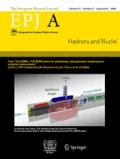Abstract.
The apparatus described here, aSPECT, will be used for a measurement of the neutrino-electron angular correlation coefficient a in the decay of free neutrons. The idea of the aSPECT spectrometer is to measure the integrated proton energy spectrum very accurately using an energy filter by electrostatic retardation and magnetic adiabatic collimation. The main ideas of the spectrometer are presented, followed by an explanation of the adiabatic transmission function. Details of the superconducting coil and of the electrode system are given, as well as a discussion of the most important systematic effects: magnetic field and electrostatic potential inhomogeneities, deviation from adiabatic motion, scattering in the residual gas, background, Doppler effect, edge effect, and detector efficiency. Using this spectrometer, the parameter a is planned to be measured with an absolute experimental uncertainty of δa ≈ 3 . 10-4, from which the axial vector to vector coupling constant ratio λ can be determined with an accuracy of δλ ≈ 0.001.
Similar content being viewed by others
References
J. Byrne, Rep. Prog. Phys. 45, 115 (1982)
D. Dubbers, Prog. Part. Nucl. Phys. 26, 173 (1991).
K. Schreckenbach, W. Mampe, J. Phys. G 18, 1 (1992).
D. Dubbers, W. Mampe, J. Döhner, Europhys. Lett. 11, 195 (1990)
F.E. Close, Nucl. Phys. A 508, 413 (1990).
J.D. Jackson, S.B. Treiman, H.W. Wyld, Phys. Rev. 106, 517 (1957).
F. Glück, I. Joó, J. Last, Nucl. Phys. A 593, 125 (1995).
B.G. Yerozolimsky, Nucl. Instrum. Methods A 440, 491 (2000)
B.G. Yerozolimsky, Phys. Lett. B 263, 33 (1991)
K. Schreckenbach, P. Liaud, R. Kossakowski, H. Nastoll, A. Bussière, J.P. Guillaud, Phys. Lett. B 349, 427 (1995)
H. Abele, M. Astruc Hoffmann, S. Baeßler, D. Dubbers, F. Glück, U. Müller, V. Nesvizhevsky, J. Reich, O. Zimmer, Phys. Rev. Lett. 88, 211801 (2002)
I.S. Towner, J.C. Hardy, in WEIN98 Conference Proceedings, Santa Fe, (1998) (World Scientific, Singapore, 1999), arXiv:nucl-th/9809087
D.H. Wilkinson, Nucl. Instrum. Methods A 488, 654 (2000).
Particle Data Group, K. Hagiwara, Phys. Rev. D 66, 010001 (2002).
C. Stratowa, R. Dobrozemsky, P. Weinzierl, Phys. Rev. D 18, 3970 (1978).
J. Byrne, P.G. Dawber, M.G.D. van der Grinten, C.G. Habeck, F. Shaikh, J.A. Spain, R.D. Scott, C.A. Baker, K. Green, O. Zimmer, J. Phys. G 28, 1325 (2002).
O. Zimmer, J. Byrne, M.G.D. van der Grinten, W. Heil, F. Glück, Nucl. Instrum. Methods A 440, 548 (2000).
J.D. Jackson, Classical Electrodynamics, 3rd edition (Wiley & Sons, 1998).
T. Hsu, J.L. Hirshfield, Rev. Sci. Instrum. 47, 236 (1976)
J. Byrne, J. Morse, K.F. Smith, F. Shaikh, K. Green, G.L. Greene, Phys. Lett. B 92, 274 (1980).
V.M. Lobashev, P.E. Spivak, Nucl. Instrum. Methods A 240, 305 (1985)
H. Backe, Phys. Scr. T 22, 98 (1988)
A. Osipowicz, arXiv:hep-ex/0109033
D. Beck, F. Ames, M. Beck, G. Bollen, B. Delauré, J. Deutsch, J. Dilling, O. Foerstner, T. Phalet, R. Prieels, W. Quint, P. Schmidt, P. Schuurmans, N. Severijns, B. Vereecke, S. Versyck, Nucl. Phys. A 701, 369c (2002).
S.R. Lee, P.G. Dawber, J. Byrne, WEIN Conference Proceedings, Dubna, CIS (JINR, Russia, 1992) p. 523.
J. Byrne, P.G. Dawber, S.R. Lee, Nucl. Instrum. Methods A 349, 454 (1994).
T.G. Northrop, The Adiabatic Motion of Charged Particles (Interscience Publ., 1963).
P.C. Clemmow, J.P. Dougherty, Electrodynamics of Particles and Plasmas (Addison-Wesley Publ. Comp., 1969).
R. Dendy (Editor), Plasma Physics: An Introductional Course (Cambridge University Press, 1993).
F. Glück, Phys. Rev. D 47, 2840 (1993).
H. Pietschmann, Acta Phys. Austriaca Suppl. (Particles, Currents, Symmetries), edited by P. Urban (Springer-Verlag, 1968) p. 88.
O. Nachtmann, Z. Phys. 215, 505 (1968).
C.G. Habeck, doctoral thesis, University of Sussex (1997).
R. Dobrozemsky, Nucl. Instrum. Methods 118, 1 (1974).
www-cfadc.phy.ornl.gov (go to: ELASTIC, Isotopomers of hydrogen ions ).
P.S. Krstic, D.R. Schultz, J. Phys. B 32, 2415 (1999)
C.F. Giese, W.R. Gentry, Phys. Rev. A 10, 2156 (1974)
R.K. Janev, Elementary Processes in Hydrogen-Helium Plasmas (Springer-Verlag, 1987).
T. Tabata, T. Shirai, At. Data Nucl. Data Tables 76, 1 (2000).
D.W. Koopman, Phys. Rev. 154, 79 (1967)
J. L’Ecuyer, J.A. Davies, N. Matsunami, Nucl. Instrum. Methods 160, 337 (1979).
F. Glück, Axisymmetric electric field calculation with charge density method, to be published.
F. Glück, Axisymmetric magnetic field calculation with Legendre polynomials and elliptic integrals, to be published.
M.W. Garrett, J. Appl. Phys. 22, 1091 (1951)
G. Engeln-Müllges, F. Reutter, Numerik-Algorithmen mit Fortran 77 Programmen (Wissenschaftsverlag, 1993) Chapt. 17.
J.H. Verner, SIAM J. Numer. Anal. 15, 772 (1978).
P.W. Hawkes, E. Kasper, Principles of Electron Optics, Vol. 1 (Academic Press, 1989).
E.R. Andrew, J. Sci. Instrum. 43, 936 (1966).
K. Kaminishi, S. Nawata, Rev. Sci. Instrum. 52, 447 (1981).
F. Glück, Axisymmetric coil design for homogeneous magnetic field, to be published.
Author information
Authors and Affiliations
Additional information
Th. Walcher
Rights and permissions
About this article
Cite this article
Glück, F., Baeßler, S., Byrne, J. et al. The neutron decay retardation spectrometer aSPECT: Electromagnetic design and systematic effects. Eur. Phys. J. A 23, 135–146 (2005). https://doi.org/10.1140/epja/i2004-10057-1
Received:
Accepted:
Published:
Issue Date:
DOI: https://doi.org/10.1140/epja/i2004-10057-1


